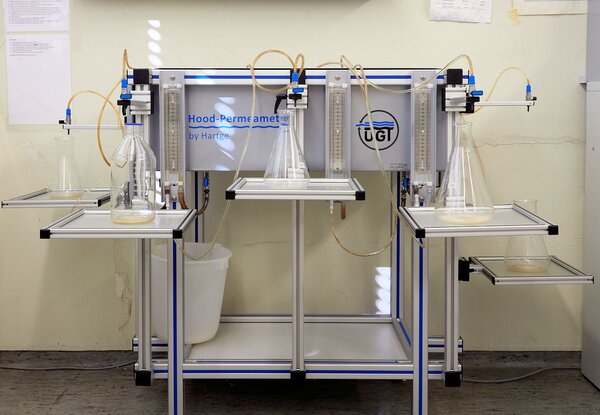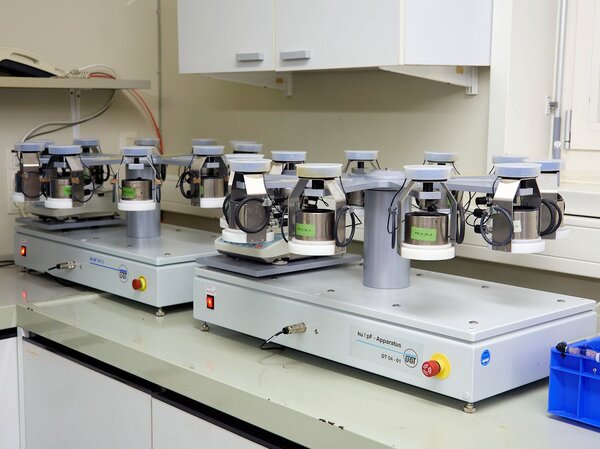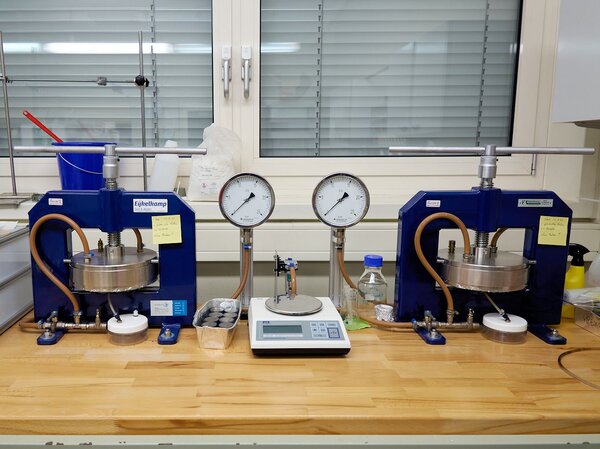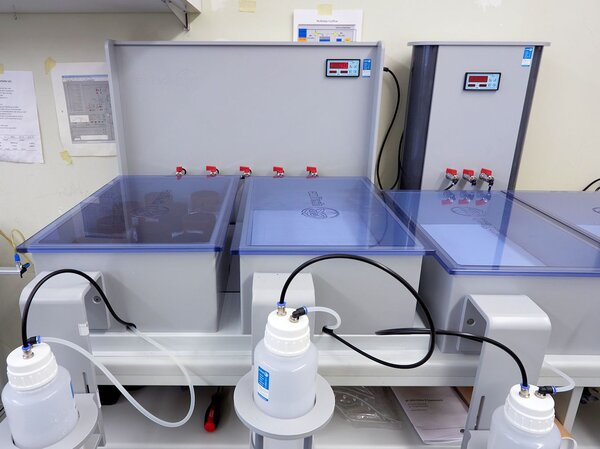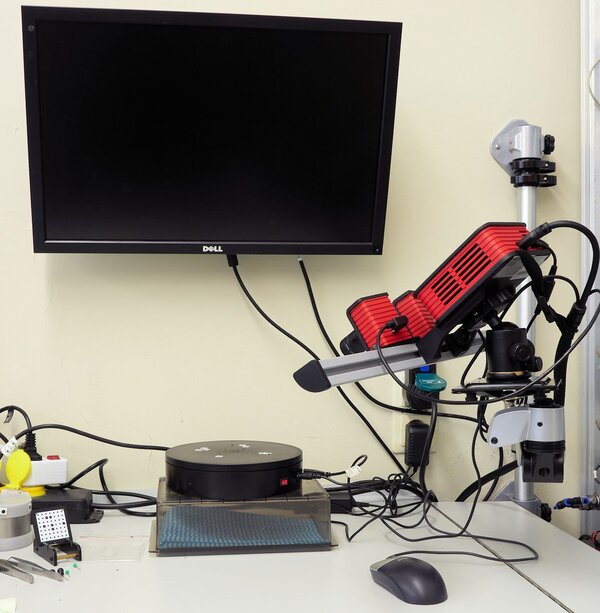
In the Lab for Soil Physics and Peat (short PeatLab) of the Thünen Institute of Climate-Smart Agriculture various soil physical properties are measured at volume-based intact (steel cylinder) and disturbed samples. The focus lies on the determination of the soil water retention and the hydraulic conductivity curve. Additionally, precise volume measurements are performed using structured light three-dimensional (3D) scanning. Soil physical properties are mainly measured for peat and other organic soils.
Determination of hydraulic properties
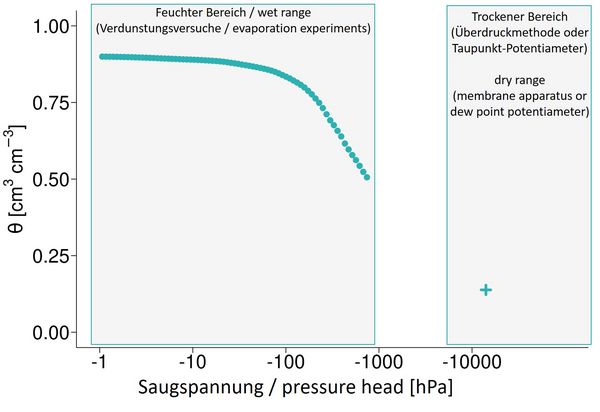
In the PeatLab hydraulic properties are determined for the saturated, wet (pressure head range down to -800 hPa) and dry (pressure heads below -10000 hPa) range of the water retention and hydraulic conductivity curve.
Under saturated conditions, hydraulic conductivity is measured under constant head, imposing steady state conditions (Reynolds et al., 2002). In the wet range, hydraulic properties are measured with evaporation experiments (Gardner and Miklich, 1962; Schindler, 1980; Dettmann et al., 2019). Thereby, the water retention and hydraulic conductivity curve are obtained simultaneously from one intact soil sample. Additionally, bulk densities and porosities are determined at the end of the experiment by standard mass calculations. In the dry range, the water content near the permanent wilting point (pF 4.2 = log10(15848) hPa) is adjusted by applying a positive pressure to the air phase of the disturbed samples and afterwards determined by weighting and drying of the samples.
Hood permeameter according to HARTGE
The saturated hydraulic conductivity is measured with the “Hood permeameter according to HARTGE” (Umwelt-Geräte-Technik GmbH, Müncheberg, Germany) with intact soil samples under constant head conditions. Thereby a constant pressure gradient is applied, imposing stationary flow. The water volume flowing through the soil sample during a specific time is determined at the end of the experiment. Saturated hydraulic conductivity is calculated following Darcy’s law (Darcy, 1856).
ku-pF apparatus
Hydraulic properties are determined with the “ku-pF-apparatus” (Umwelt-Geräte-Technik GmbH, Müncheberg, Germany) by evaporation experiments (Gardner and Miklich, 1962; Schindler, 1980; Dettmann et al., 2019). The measurement principle is based on the simultaneous measurement of pressure heads (suction, matrix potential) and sample mass. The water retention curve is determined by relating the column-averaged water contents to pressure heads (measured with tensiometer). The hydraulic conductivity curve is calculated by relating the vertical water flux in the middle of the soil column to the gradients of the hydraulic potential between the measured pressure heads. Hydraulic properties are determined for the measurement range of the tensiometer, which is between 0 to approximately -800 hPa.
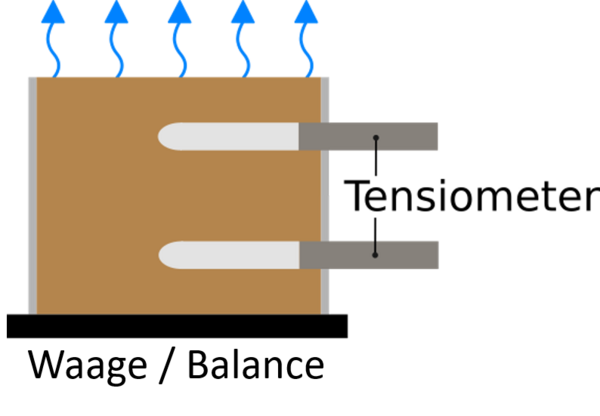
The experiment starts with saturated samples. During the experiment 10 samples rotate on the “ku-pF-apparatus”. Decreasing weights and pressure heads are measured at a chosen time interval (e.g. 10 Minutes). The experiment ends at pressure heads of approximately -800 hPa. A detailed description is given in Dettmann et al. (2019).
Pressure membrane apparatus
With the “Pressure membrane apparatus” (Eijkelkamp, Giesbeek, The Netherlands) pressure heads can be adjusted between 1000 hPa to 16000 hPa by applying a positive pressure to the air phase of a soil sample (Dane and Hopmans, 2002). In the PeatLab, the device is used to determine the water retention near the permanent wilting point (pF 4.2 = log10(15848) hPa).
For the measurement, two porous, saturated cellophane membranes are placed in the “Pressure membrane apparatus”, by avoiding any air inclusions. Field moist samples are then packed in plastic cylinders (Ø: 3.50 cm, height: 1.00 cm) and placed on the membranes. Afterwards, the “Pressure membrane apparatus” is closed and a positive pressure (e.g. 15848 hPa) is adjusted and applied to the samples. The experiment ends after samples reach hydraulic equilibrium. The water content is determined afterwards gravimetrically by drying the samples in an oven. More details can be found in Bechtold et al. (2018), Dettmann et al. (2019) and the user manual (Eijkelkamp, 2022).
WP4C PotentiaMeter
The „WP4C PotentiaMeter” (Decagon Devices, Inc., Pullman, WA) can measure the water potential between -1000 to -3000000 hPa with increased uncertainties between -1000 to -5000 hPa. For the measurement, the sample is placed in a closed chamber where the dewpoint and sample temperature are measured and used to infer relative humidity and soil water potential. More information is given in Schelle et al. (2013) and the user manual (Decagon Devices, 2014).
pF pressure step module
The “pF pressure step module” (ecoTech Umwelt-Meßsysteme GmbH, Bonn, Germany) can dewater samples for pressure heads between approximately -3 to -750 hPa. Therefore, steel cylinders are placed on an airtight membrane where a negative pressure is applied to the water phase of the samples. After the sample reaches equilibrium, the water content is determined gravimetrically. Thereby, individual points of the water retention curve can be determined. By adjusting specific pressure heads, samples can also be prepared for further laboratory experiments, e.g. for the determination of sample volume with a 3D scanner or incubation experiments.
RangeVision Spectrum
The “RangeVison Spectrum” (RangeVision EU, Brno, Czech Republic) is a high-resolution 3D scanner based on structured light technology. Scanned objects can be processed as 3D Models. In the PeatLab, the scanner is used to determine volumes of peat samples at specific pressure heads or water contents.
References
Bechtold, M., Dettmann, U., Wöhl, L., Durner, W., Piayda, A. and Tiemeyer, B. 2018. Comparing Methods for Measuring Water Retention of Peat Near Permanent Wilting Point. Soil Sci. Soc. Am. J. 82 No. 3, 601-605. doi: https://doi.org/10.2136/sssaj2017.10.0372.
Dane, J. and Hopmans, J.W. 2002. Laboratory. In: Dane, J.H. and Topp, G.C. (eds): Methods of Soil Analysis: Part 4 - Physical Methods. 675-719, Soil Science Society of America, Madison. doi: https://doi.org/10.2136/sssabookser5.4.c25.
Darcy, H.P.G. (1856) Dètermination des lois d'ècoulement de l'eau à travers le sable.
Decagon Devices (2014) WP4C Dewpoint PotentiaMeter Operator's Manual, Decagon Devices, Inc., Pullmann, WA.
Dettmann, U., Bechtold, M., Viohl, T., Piayda, A., Sokolowsky, L. and Tiemeyer, B. 2019. Evaporation experiments for the determination of hydraulic properties of peat and other organic soils: An evaluation of methods based on a large dataset. J. Hydrol. 575, 933-944. doi: https://doi.org/10.1016/j.jhydrol.2019.05.088.
Eijkelkamp (2022) Pressure membrane apapratus user manual, Royal Eijkelkamp, Giesbeek, the Netherlands.
Gardner, W.R. and Miklich, F.J. 1962. Unsaturated conductivity and diffusivity measurements by a constant flux method. Soil Sci. 93(4), 271-274. doi: https://doi.org/10.1097/00010694-196204000-00008.
Reynolds, W.D., Elrick, D.E., Youngs, E.G., Booltink, H.W.G. and Bouma, J. 2002. The Soil Solution Phase - Laboratory Methods. In: Dane, J.H. and Topp, G.C. (eds): Methods of Soil Analysis; Part 4 - Physical Methods. 802-816, Soil Science Society of America, Inc., Madison.
Schelle, H., Heise, L., Jänicke, K. and Durner, W. 2013. Water retention characteristics of soils over the whole moisture range: A comparison of laboratory methods. Eur. J. Soil Sci. 64(6), 814-821. doi: https://doi.org/10.1111/ejss.12108.
Schindler, U. 1980. Ein Schnellverfahren zur Messung der Wasserleitfähigkeit im teilgesättigten Boden an Stechzylinderproben. Archiv für Acker- und Pflanzenbau und Bodenkunde - Archives of Agronomy and Soil Science 24(1), 1-7.

![[Translate to English:] [Translate to English:]](/media/_processed_/6/4/csm_titel_CO2Kampagne8_afeea2273e.png)
![[Translate to English:] [Translate to English:]](/media/_processed_/4/1/csm_titel_93px_CO2Kampagne8_9b0f3354d4.png)
